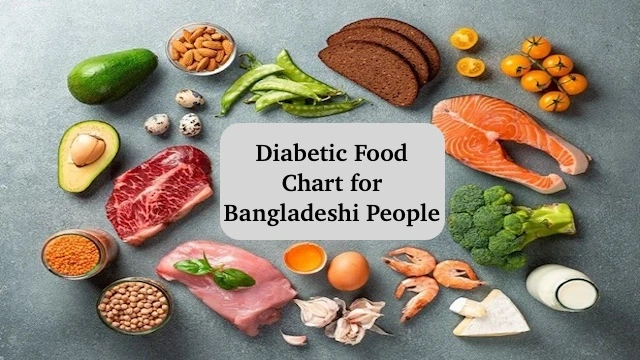Complete Guide: Diabetic Food Chart for Bangladeshi People
Managing diabetes requires a balanced diet that includes a variety of foods to help control blood sugar levels, maintain a healthy weight, and provide essential nutrients. This guide offers a comprehensive food chart specifically tailored for Bangladeshi people, considering local foods and cultural dietary habits.
Many of us trying to find a complete guide that which types of foods should considered for diabetic food charts, we hope the below given information may help you. It will work for both males and females.

Important Considerations (Quick View)
- Focus on whole, unprocessed foods: Choose brown rice, whole wheat roti, vegetables, fruits, legumes (dal, lentils), and lean protein sources (fish, chicken).
- Portion Control: Use smaller plates to control how much you eat.
- Fiber is Key: Include vegetables, fruits, and whole grains for blood sugar regulation.
- Healthy Fats: Choose olive oil, mustard oil, and fats from fish. Limit saturated and unhealthy fats.
- Sweeteners with Caution: Limit added sugars and sugary drinks. Opt for small amounts of natural sweeteners like honey or dates in moderation.
- Read Food Labels: Pay attention to carbohydrate content to manage blood sugar.
Principles of a Diabetic Diet
- Balance: Include a mix of carbohydrates, proteins, and fats in your meals.
- Portion Control: Keep portion sizes in check to manage blood sugar levels.
- Regular Meals: Eat at regular intervals to prevent spikes and drops in blood sugar.
- Low Glycemic Index (GI) Foods: Choose foods that have a low GI to maintain stable blood sugar levels.
Sample Diabetic Meal Timing (Bangladeshi Style)
- Breakfast (6:00 AM – 8:00 AM)
- Mid-Morning Snack (10:00 AM – 11:00 AM)
- Lunch (1:00 PM – 3:00 PM)
- Afternoon Snack (3:00 PM – 5:00 PM)
- Dinner (7:00 PM – 9:00 PM)
- Before Bed Snack (Optional)
Groups of foods & recommended choices
#Carbohydrates
- Rice: Opt for brown rice or parboiled rice instead of white rice.
- Whole Grains: Whole wheat, barley, oats, and quinoa.
- Legumes: Lentils, chickpeas, and kidney beans.
#Proteins
- Fish: Hilsa, Rui, Katla, and other local varieties. Aim for at least two servings of fish per week.
- Poultry: Chicken (preferably lean cuts and skinless).
- Eggs: Limit to 2-3 eggs per week if cholesterol is an issue.
- Dairy: Low-fat milk, yogurt, and paneer.
- Plant-Based: Tofu, tempeh, and legumes.
#Fats
- Healthy Oils: Mustard oil, olive oil, and canola oil.
- Nuts and Seeds: Almonds, walnuts, chia seeds, and flaxseeds.
#Vegetables
- Non-Starchy: Spinach, cauliflower, cabbage, green beans, okra, and bitter gourd (karela).
- Starchy: Sweet potatoes, carrots, and peas (consume in moderation).
#Fruits
- Low GI Fruits: Apples, pears, oranges, berries, guava, and papaya.
- High GI Fruits: Limit intake of mangoes, bananas, and grapes.
#Snacks
- Healthy Options: Nuts, seeds, roasted chickpeas, and fruit slices.
- Avoid: Processed snacks, sweets, and fried foods.
Sample Meal Plan
Breakfast
- Option 1: One bowl of oatmeal with a tablespoon of chia seeds and a serving of berries.
- Option 2: Whole wheat roti with scrambled eggs and a side of mixed vegetables.
- Option 3: A smoothie made with low-fat yogurt, spinach, and a small apple.
Mid-Morning Snack
- A handful of almonds or a small piece of fruit like an apple or a pear.
Lunch
- Option 1: Brown rice with grilled fish, a serving of lentils (dal), and a side of mixed vegetables.
- Option 2: Whole wheat chapati with chicken curry (made with minimal oil), a side salad, and a serving of plain yogurt.
- Option 3: Quinoa salad with chickpeas, tomatoes, cucumbers, and a lemon-mustard dressing.
Afternoon Snack
- Sliced cucumber and carrot sticks with a yogurt-based dip or hummus.
Dinner
- Option 1: Baked or grilled fish with a side of stir-fried green vegetables and a small serving of brown rice or quinoa.
- Option 2: Chicken or tofu curry with whole wheat roti and a side of steamed vegetables.
- Option 3: Mixed vegetable soup with a side of whole grain bread or chapati.
Evening Snack
- A small bowl of yogurt with a teaspoon of flaxseeds or a piece of dark chocolate (in moderation).
Additional Tips: Tips for Managing Diabetes
- Drink plenty of water: Stay hydrated for overall health and blood sugar control.
- Cook at home: Control ingredients and portion sizes.
- Be physically active: Exercise helps manage blood sugar levels. Engage in at least 30 minutes of moderate exercise daily, such as walking, cycling, or swimming.
- Limit Sugar and Refined Carbs: Avoid sugary drinks, sweets, and foods made with white flour.
- Consult a doctor or registered dietitian: Work with a registered dietitian to tailor a meal plan that fits your needs and preferences.
Conclusion
Managing diabetes involves making informed food choices and maintaining a balanced diet. This guide provides a framework for creating a diabetic-friendly food chart tailored to Bangladeshi dietary habits. Remember to consult with healthcare professionals to ensure your diet meets your specific health needs.
Remember: This is a general guide. You may need to adjust it based on your individual needs and preferences. Consult your doctor or a registered dietitian for a personalized diabetic meal plan.
Sources
- https://einsteinmed.edu/uploadedFiles/departments/dfsm/sapphire/Healthy%20Eating%20with%20Diabetes%20(Bengali).pdf
